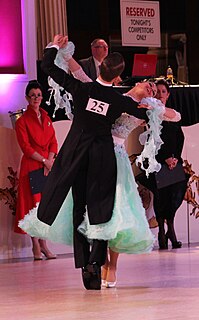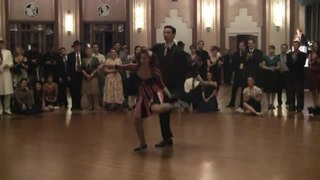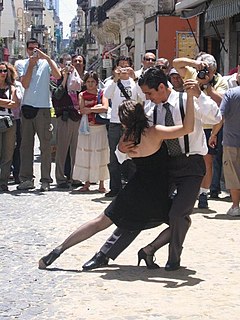
Ballroom dance is a set of partner dances, which are enjoyed both socially and competitively around the world. Because of its performance and entertainment aspects, ballroom dance is also widely enjoyed on stage, film, and television.
In partner dancing, connection is a physical communication method used by a pair of dancers to facilitate synchronized dance movement, in which one dancer directs the movements of the other dancer by means of non-verbal directions conveyed through a physical connection between the dancers. It is an essential technique in many types of partner dancing and is used extensively in partner dances that feature significant physical contact between the dancers, including the Argentine Tango, Lindy Hop, Balboa, East Coast Swing, West Coast Swing, Salsa, and Modern Jive.
In some types of partner dance, lead and follow are designations for the two dancers' roles in a dance pairing. The leader is responsible for guiding the couple and initiating transitions to different dance steps and, in improvised dances, for choosing the dance steps to perform. The leader communicates choices to the follower, and directs the follower by means of subtle physical and visual signals, thereby allowing the pair to be smoothly coordinated.

The Charleston is a dance named after the harbor city of Charleston, South Carolina. The rhythm was popularized in mainstream dance music in the United States by a 1923 tune called "The Charleston" by composer/pianist James P. Johnson which originated in the Broadway show Runnin' Wild and became one of the most popular hits of the decade. Runnin' Wild ran from 29 October 1923 through 28 June 1924. The peak year for the Charleston as a dance by the public was mid-1926 to 1927
West Coast Swing is a partner dance with roots in the Lindy Hop. It is characterized by an elastic look that results from its extension-compression technique of partner connection and is danced primarily in a slotted area on the dance floor. The dance allows for both partners to improvise steps while dancing together, putting West Coast Swing in a short list of dances that emphasize improvisation.

Swing dance is a group of dances that developed with the swing style of jazz music in the 1920s–1940s, with the origins of each dance predating the popular "swing era". During the swing era, there were hundreds of styles of swing dancing, but those that have survived beyond that era include: Lindy Hop, Balboa, Collegiate Shag, and Charleston. Today, the most well-known of these dances is the Lindy Hop, which originated in Harlem in the early 1930s. While the majority of swing dances began in African American communities as vernacular African American dances, some influenced swing-era dances, like Balboa, developed outside of these communities.

Salsa is a Latin dance associated with the music genre of the same name which originated in the 1960s in New York City. Salsa is an amalgamation of Cuban dances that were popular in the ballrooms and nightclubs of Havana by the end of the 1950s, as well as American jazz dances. It was primarily developed by Puerto Ricans living in New York (Nuyoricans) in the late 1960s and early 1970s. Different regions of Latin America and the United States have distinct salsa styles of their own, such as Cuban, Puerto Rican, Cali Colombia, L.A. and New York styles. Salsa dance socials are commonly held in nightclubs, bars, ballrooms, restaurants, and outside, especially when part of an outdoor festival.

In partner dancing, closed position is a category of positions in which partners hold each other while facing at least approximately toward each other.

Tango is a partner dance, and social dance that originated in the 1880s along the Río de la Plata, the natural border between Argentina and Uruguay. It was born in the impoverished port areas of these countries, with enslaved African populations. The tango is the result of a combination of African Candombe, Spanish-Cuban Habanera, and Argentinian Milonga. The tango was frequently practiced in the brothels and bars of ports, where business owners employed bands to entertain their patrons with music. The tango then spread to the rest of the world. Many variations of this dance currently exist around the world.

Partner dances are dances whose basic choreography involves coordinated dancing of two partners, as opposed to individuals dancing alone or individually in a non-coordinated manner, and as opposed to groups of people dancing simultaneously in a coordinated manner.

Latin dance is a general label, and a term in partner dance competition jargon. It refers to types of ballroom dance and folk dance that originated in Latin America.
This is a list of dance terms that are not names of dances or types of dances. See List of dances and List of dance style categories for those.

In ballroom dancing, directions of progressive movement, in particular, directions of steps, can be indicated either in relation to the room or in relation to the body position. Directions of turns, although there are only two of them, may also be indicated in several ways.

Merengue is a style of Dominican music and dance. Partners hold each other in a closed position. The leader holds the follower's waist with the leader's right hand, while holding the follower's right hand with the leader's left hand at the follower's eye level. Partners bend their knees slightly left and right, thus making the hips move left and right. The hips of the leader and follower move in the same direction throughout the song. Partners may walk sideways or circle each other, in small steps. They can switch to an open position and do separate turns without letting go each other's hands or releasing one hand. During these turns they may twist and tie their handhold into intricate pretzels. Other choreographies are possible.
The hustle is a catchall name for some disco dances which were extremely popular in the 1970s. Today it mostly refers to the unique partner dance done in ballrooms and nightclubs to disco music. It has some features in common with mambo, salsa and swing dance. Its basic steps are somewhat similar to the discofox, which emerged at about the same time and is more familiar in various European countries. In the 1970s there was also a line dance called the hustle. Modern partner hustle is sometimes referred to as New York hustle, however, its original name is the Latin hustle. People still do this dance around the world today.

Argentine tango is a musical genre and accompanying social dance originating at the end of the 19th century in the suburbs of Buenos Aires and Montevideo. It typically has a 2
4 or 4
4 rhythmic time signature, and two or three parts repeating in patterns such as ABAB or ABCAC. Its lyrics are marked by nostalgia, sadness, and laments for lost love. The typical orchestra has several melodic instruments and is given a distinctive air by the small button accordion called the bandoneon. It has continued to grow in popularity and spread internationally, adding modern elements without replacing the older ones. Among its leading figures are the singer and songwriter Carlos Gardel and composers/performers Francisco Canaro, Juan D'Arienzo, Carlos Di Sarli, Osvaldo Pugliese, and Ástor Piazzolla.

In partner dances, close embrace is a type of closed position where the leader and follower stand facing each other chest-to-chest in full or partial body contact. The dancers usually stand offset from one another, such that each has his or her right foot in between the feet of his or her partner. When in close embrace, the dance is led with the whole body, rather than with the arms or with visual cues. Various partner dances make use of this position, most notably Argentine Tango, but also Balboa, Collegiate Shag, Swing Walk, Blues, and others.

Contra body movement is used in ballroom dances, such as waltz, foxtrot, tango, and quickstep. It comprises turning the body against the movement of the legs: either moving forward with the right foot and the left hip and shoulder, or vice versa.
The promenade position is a dance position in ballroom and other dances. It is described differently in various dance categories.














